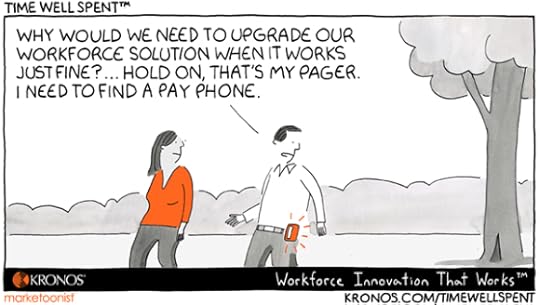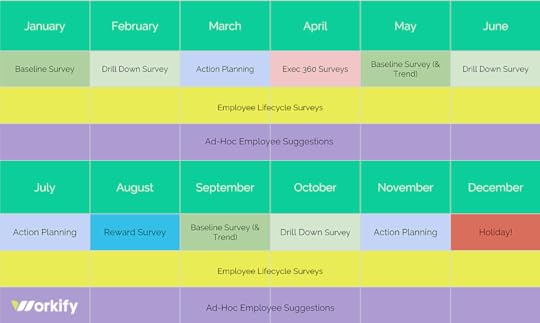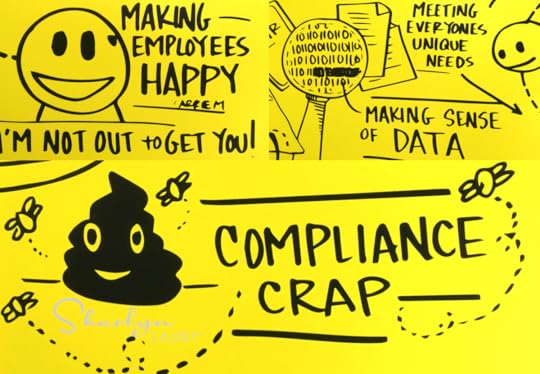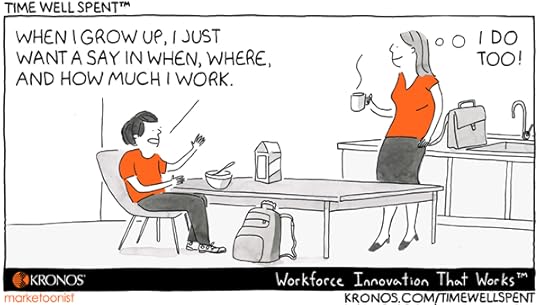Sharlyn J. Lauby's Blog, page 121
March 16, 2018
Know When to Upgrade Your Technology – Friday Distraction
(Editor’s Note: Today’s article is brought to you by our friends at Kronos , a leading provider of quality workforce management and human capital management cloud solutions. For the fourth consecutive year, Kronos has been named one of the according to global research and consulting firm Great Place to Work. Congrats to them! Enjoy the article.)
You know I’m an Apple fan. So, every time the latest iPhone or iPad comes out, I go through this big internal debate. Should I or shouldn’t I upgrade? I’m sure you do the same when your favorite technology provider comes out with their latest and greatest.
That’s why I couldn’t help but laugh at this Time Well Spent cartoon from our friends at Kronos. Not only because I do remember the days when I wore a pager and had to call in using a pay phone, but because I laugh at myself for the upgrade debate I have every time a new piece of tech comes out. The truth is I should follow the thought process that organizations use when it’s time to consider upgrades.
Will a technology upgrade increase revenue? The first question that organizations ask themselves is “Will this technology bring us more revenue?”. Pure and simple. The technology might allow the company to offer more products and services. Or maybe it would allow customers to purchase more. Maybe it will make the customer experience “easy to buy, easy to use, and easy to share with others”.
Would a technology upgrade decrease expenses? It’s also possible that the new technology would quickly pay for itself and decrease operational expenses. While it might not be an increase in revenue, a decrease in expenses could be large enough to justify the upgrade. Even a small decrease in expenses could also be reinvested back into the customer experience, ultimately resulting in greater customer satisfaction (and hopefully more revenue!)
Can a technology upgrade improve productivity? Sometimes technology doesn’t directly bring extra revenue or less expenses, but it does automate repetitive work. This allows the organization to use headcount in a very productive way on activities that matter to customers and employees. Don’t discount this approach, using technology to make the workforce more productive can create better employee and customer satisfaction (positively impacting the bottom-line).
Does our current technology hold us back? There’s one other question that companies ask themselves when it’s time to upgrade. Maybe the current tech is working just fine, and the employees love it. But if the company’s competitive set is upgrading, then there could come a point where the old technology keeps the organization from moving forward. Customers will come to expect the new technology. If those expectations aren’t met, customers may go elsewhere.
Maybe the next time Apple announces the next new product that everyone must have, I need to step back and use the same process that companies use to decide if it’s time to upgrade their technologies.
The post Know When to Upgrade Your Technology – Friday Distraction appeared first on hr bartender.






March 15, 2018
6 Reasons to Attend the 2018 SHRM Talent Conference – #SHRMTalent
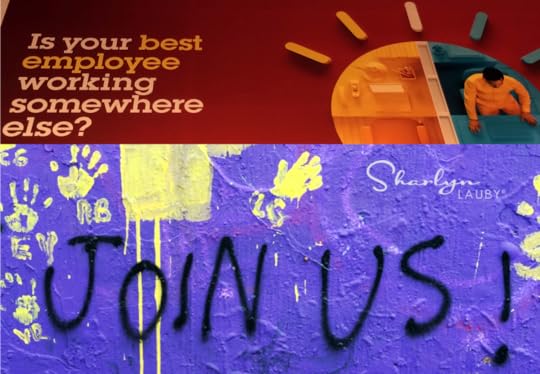
I know there’s a lot of conversation right now about the Society for Human Resource Management (SHRM) Annual Conference taking place June 17-20, 2018 in Chicago. I’m excited to be attending this year.
But I want to talk about a conference that happens before SHRM Annual. It’s the SHRM Talent Conference & Expo. This year’s event will be taking place April 16-18, 2018 at Caesar’s Palace in Las Vegas. As the name implies, SHRM Talent is focused on talent acquisition, development, and management. It’s a smaller event, so the sessions are more interactive and the opportunities for networking are terrific.
I’ve had the opportunity to attend SHRM Talent for a few years now, so I thought I would share a few reasons that you might want to check this event out.
Size. SHRM Talent is the right size. I’ve mentioned this already, so I won’t belabor the point. But for people who have attended SHRM Annual with its 20,000+ attendees and said, “never again”, consider this event. It’s in a hotel (not a convention center). It’s big enough for great learning and networking but small enough to see everything.
Seminars. There are seminars on the front/back. If you’ve been trying to decide between going to a formal workshop and attending a conference, SHRM Talent allows you to do both. The seminars being offered include:
Talent Acquisition: Creating Your Organization’s Strategy
Succession Planning: Preparing for Future Talent Needs
L&D: Developing Organizational Talent
Behavioral Interviewing: Practices for Hiring Smart
Recertification credits. The conference is preapproved for SHRM-SCP and SHRM-CP recertification credits. And your certification portal will automatically be credited, so you don’t have to spend your time worrying about codes and paperwork.
SMART Stage. If you love short presentation formats like DisruptHR and TEDtalks, the conference offers something similar on the SMART Stage. One of the sessions that caught my eye is Joey V. Price’s “Building Your Business Brand and Creating a Social Army”. And I’m going to be talking about “Four Ways to Measure Your Social Recruiting Strategy”.
Location. It’s in Vegas. I believe that conference locations are important. Attending a learning event doesn’t mean you can’t have a little fun too. I love using conferences to work and recharge at the same time.
Expo! If your organization is looking for something new in the talent space, here’s the opportunity to check out HR companies, have conversations, learn something at a couple of demos, etc. The professionals in the expo hall are super knowledgeable.
According to The Conference Board’s C-Suite Challenge 2018, the number one concern facing organizations is attracting and retaining talent. That means recruiting and retention should be priority numero uno for human resources departments. Conferences are great places to learn new things. They’re also good places to remember the basics. Sometimes we need to get out of the office to be reminded.
So, I’m not saying don’t go to SHRM Annual. Frankly, I’m going to both. SHRM Annual has a different purpose and vibe. If you haven’t been to SHRM Talent, this might be the year to check it out. Because talent is going to remain a top priority for businesses for a very long time.
Image captured by Sharlyn Lauby after speaking at the SHRM Annual Conference in Washington, DC
The post 6 Reasons to Attend the 2018 SHRM Talent Conference – #SHRMTalent appeared first on hr bartender.






March 13, 2018
Employee Engagement Roadmap: It Is Not Too Late to Create Yours for 2018!
(Editor’s Note: Today’s article is brought to you by our friends at Workify , an all-in-one employee engagement platform that makes it easy for companies to understand and take action on what’s motivating and demotivating employees throughout the employee experience. Enjoy!)
Over the course of last year, we talked a lot about employee engagement. We’ve discussed how to effectively measure it using employee net promoter score (eNPS), the importance of setting realistic expectations for the company’s engagement efforts, and strategies for getting to the root cause of engagement issues. However, one of the biggest challenges that organizations face is not having a clear employee engagement plan for the year to guide activities. As a result, they don’t accomplish nearly as much as they wanted to (or as much as the senior management team expected).
The question becomes…how do we make employee engagement a part of our everyday activities. How does engagement become a part of culture? The answer is by creating an employee engagement roadmap. Roadmaps are plans that match short-term activities with long-term goals.
In today’s business environment, organizations create roadmaps for a variety of key processes. For example, organizations create product roadmaps. They have customer and candidate experience roadmaps. When someone is hired, the company provides the new employee with an employee roadmap.
Here’s Your 2018 Employee Engagement Roadmap
In the context of employee engagement, organizations can create roadmaps that connect their actions with their long-term goals. Here’s a sample employee engagement roadmap.
The specific activities would include:
First Quarter (Q1) – During the quarter, companies can spend their time creating an initial baseline. This gives them a place to compare results, which will come in handy later in the year. Trust me. In addition, the company can conduct their first drill down survey to get more specific details.
Second Quarter (Q2) – In this quarter, organizations could launch both new hire and exit feedback mechanisms. This allows the company to gather insights closer to real-time, which means they can address any issues faster and not allow them to fester.
Third Quarter (Q3) – At this point, six months has passed, and the organization has probably made some changes based on the drill down survey and new hire / exit feedback. Time to conduct a new baseline survey. Also, let me add that this might be a good time to give management some tools with a “Leadership 360” assessment and coaching.
Fourth Quarter (Q4) – After the new baseline, the company should follow-up with another drill down survey. Those results can be reviewed in the company’s annual operational planning session and used to update the roadmap for 2019.
All along the way, regular employee “lifecycle” or pulse surveys can be used to monitor progress. Also, organizations should always be prepared to accept and implement ad-hoc suggestions. Be prepared to try new things.
Convincing Senior Management the Company Needs an Engagement Roadmap
I completely understand that having a roadmap isn’t enough. HR has to convince the senior management team to support it. And by support, I mean not only with their words and actions but with a budget and headcount. Here are three steps to consider:
1. Show the connection between engagement and the bottom-line. We already know employee engagement is an important topic for businesses. So, I’m not going to belabor the point. If you’re looking for some data and trends, check out Deloitte’s Global Human Capital Trends Report 2017.
2. Start with getting a few key executives that are willing to be roadmap sponsors. I don’t want to say this is an easy sell, because it’s not. Organizations have strategies and resources they need to balance. But getting resources becomes an easier sell when the organization can visualize the roadmap.
3. Start small. Slowly build support and momentum. That’s how roadmaps have impact and become a part of company culture. As one HR professional to another, consider the concept of under promising and over delivering. Take a small goal, hit a home run, then go ask for more.
It’s Not Too Late to Create a Roadmap
No organization wants their investments toward employee engagement to lose value. Employee engagement is too important. By using an employee engagement roadmap, the company can stay focused, use resources wisely, and measure progress on their overall effort.
I hope you like the roadmap idea and will use it in your organization. Our friends at Workify have created a guide to help you get started. Take a look. It can be a great first step toward having a true impact on employee engagement.
The post Employee Engagement Roadmap: It Is Not Too Late to Create Yours for 2018! appeared first on hr bartender.






March 11, 2018
How to Support the Creative Process of Ordinary People
I loved this Harvard Business Review white paper by Teresa Amabile titled, “In Pursuit of Everyday Creativity”. From a business context, we’re constantly focused on creativity and innovation. We place value on it.
My takeaway from the white paper is that we tend to label people as “creative” versus looking at a creative process that anyone could use successfully. It also raised some questions about how we view creativity. For example:
How do people learn a creative process? I’ve heard of “creativity” training, but do those programs outline a creative process or just dive into creative activities? Both are important. But I can see organizations that adopt a creative process also being open to the outcomes of that creative process. Most creative processes have a:
preparation step,
ideation step, and a
implementation step.
These three steps are very similar to most business strategies. The preparation step might mirror the assessment or analysis phase in many business models. Ideation would be similar to brainstorming or problem-solving. And implementation would be same, maybe with the addition of a debrief.
When do employees learn it? Many organizations look for employees to demonstrate creativity in the hiring process, so is the assumption that individuals will come to the company with knowledge about creativity on Day One? Or can employees learn a creativity model during orientation and onboarding?
Maybe it’s a little bit of both. New hires might come to the company with some creative experiences, then learn the company’s creative process during orientation and onboarding. Not only does that provide employees with a framework, but it also sends the message that the company values being creative so much that they have adopted a process to encourage it.
How can managers support it? And this is probably the most important question. Once the organization buys-into a creative process, and educates employees on how to use it, then what activities can managers do to support the process and the outcomes that are a result of using the process.
The worst thing the company can do is tell candidates that creativity is important during interviews, promote a creative process during onboarding, and then, not support it in the daily operation. Managers need to be given the tools to encourage creativity. In addition, they need to be trained on how to deal with the terrific (and less than terrific) ideas that come out of the creativity process.
If organizations want to encourage creativity at every level of the business, they must figure out how to put some structure around it. I don’t view that as counterintuitive. The structure isn’t around the ideas, results, and outcomes. It’s around the process. Every employee that follows the process won’t have the same outcome. And that’s what creativity is all about, right?
The post How to Support the Creative Process of Ordinary People appeared first on hr bartender.






March 9, 2018
Bookmark This! #HR Project Management Edition
I was in a meeting recently where someone commented that HR pros don’t know project management. And I thought, really? Managing projects is one of the largest responsibilities we have in human resources. It could be a small project like organizing an employee event or a large scale project such as implementing a new software solution. Regardless of size, projects are an important part of what we do.
As such, we should manage projects well. That means having some understanding of project management terminology, processes, and techniques. Some of the activities that come to mind are launch meetings, maintenance plans, communications, pilot programs, and project plans. It got me thinking about my list of go-to project management resources, so I thought I would put together a list.
First off, I have a couple of books on my shelf about managing projects. “Project Management Step-By-Step” by Larry Richman and “Project Management in 24 Hours” by Nancy Mingus. Both of these are practical how-to guides for the project manager. I use them as a regular resource.
In addition to books, I read a couple of project management blogs on a regular basis. So, if you’d rather read blogs instead of books, check out these couple of posts:
Top 10 Project Management Blogs to Follow in 2017
The 58 Most Insanely Useful Project Management Blogs and Resources
You might not want to follow all of these, but look for blogs that keep popping up on lists. That’s one of the reasons I like reading those “top lists” articles because I look for trends.
Another way to learn how to manage projects is by actually doing it. There are several apps on the market that can assist with managing projects. For example, when we were doing some recent updates to HR Bartender, we worked with the developer using Basecamp. Here are some articles on the topic:
From CIO.com: The 7 best project management mobile apps
From Zapier: The 18 Best Free Project Management Apps
From PC Magazine: The Best Project Management Software of 2018
Again, the goal isn’t to download and test-drive all of these. That would quickly turn into its own project! Think of your needs, look at the names that continue to show up, and then select 2-3 (max!) to try.
I’m not sure that there’s an expectation for HR professionals to obtain their Project Management Professional (PMP) Certification. But knowing the principles in terms of scheduling, budgeting, evaluation, etc. is essential. I recently heard an easy to remember way to manage project data that I plan to incorporate into my project management toolkit. Call it the 3 C’s:
CONFIRM existing information
CLEANUP incorrect information
CONFIGURE processes for the future
There’s one other aspect of project management that we need to keep in mind. It’s the people part. Successfully managing projects requires communication, decision making, problem solving, and conflict management. Not only does HR need to know these things, but they need to make sure that everyone else knows them too. Because part of the reason that HR needs to know the principles of project management is so they can help the rest of the organization learn them too.
So, I’m curious. What books, blogs, or apps are on your project management resource list?
P.S. Today’s image was taken at the 2017 Society for Human Resource Management (SHRM) Annual Conference. This year’s conference will be held in Chicago, IL on June 17-20, 2018. Hope to see you there!
The post Bookmark This! #HR Project Management Edition appeared first on hr bartender.






March 8, 2018
How to Create a Vision Board on Pinterest
I don’t know about you, but I have some plans for the future. However, sometimes simply writing down goals isn’t enough. I want to see more than the words. I want to see the future.
Vision boards can be a good way to do that. They are a tool used to help clarify, concentrate, and maintain focus on a specific life goal. Literally, a vision board is any sort of board on which you display images that represent whatever you want to be, do, or have in your life. I’m thinking a perfect place to keep a vision board is Pinterest.
A couple of years ago, I wrote a 5-day plan for learning Pinterest. Since then, I continue to see activity and engagement on the platform. My experience with Pinterest is that it’s less of a dialogue or conversation platform and more of an inspiration, utilization platform.
If you’re looking for a way to stay focused on a goal, consider creating a vision board to help make that happen. Here are five things to note:
You can make it secret. Not ready to share your vision board with the whole world? No problem. Pinterest has a feature that allows you to make a board “secret” so only you can see it.
Section it to fit your needs. Pinterest recently added a nice feature where a “board” can have “sections”. So, your vision board could have a personal AND a professional section. Or it could have wellbeing sections like in the Gallup-Healthways’ model: purpose, financial, social, community, physical.
Pin images, articles, and quotes that help you achieve your goals. One of the things I like about Pinterest is that I can pin a variety of things – images, articles, quotes. I can pin stuff from the internet and photos I’ve taken or articles I’ve written. Bottom-line: it’s flexible.
Change it when you want to. After pinning something, you can move it to another board, or delete it completely. Let’s say you pin a list of the top leadership traits. Couple months later, you see a better list. Delete the old one and replace it with the new one.
Delete what doesn’t work. One of the downsides to vision boards can be a feeling that you look at it and say, “I’m not getting to my vision fast enough.” Or “I’ll never achieve the goal.” It’s important to remember that our goals change regularly, and we have to be willing to let go of some goals in order to make other ones happen. Vision boards must be flexible to be effective.
Your vision board can be portable. I’m not against the bulletin board type vision project, but there’s something nice to me about having my vision board with me all the time. If I’m at a conference, and I hear something, I can immediately post it. Versus going home, then finding/printing/posting it.
When you’re ready, you can share it. There might be components of your vision board that involve coworkers, family or friends. Maybe you want to start a business. Or move to a different city. Pinterest allows you to share boards with others.
Vision boards can help us with our career goals, life goals, and maybe even retirement goals. We have the flexibility to create something that fits our needs. Because the goal with a vision board is to make it happen. So, if it works, take advantage of what Pinterest can offer.
Image captured by Sharlyn Lauby after speaking at the Flora Icelandic HR Management Conference in Reykjavik, Iceland
The post How to Create a Vision Board on Pinterest appeared first on hr bartender.






March 6, 2018
Organizations Don’t Change Until People Do
Organizations decide they’re going to change all the time. Especially during times like we’re experiencing today, when recruiting is tough, engagement is a challenge, and retention is a top priority. It’s not unusual for an organization to say, “We need to change so we can get the best talent and crush the competition.” But organizational change doesn’t happen just because:
Something goes offline, like a system
A kickoff meeting happened to start a project
An acknowledgement was made that change needs to happen
An email was sent to all interested parties
A training session was held for employees
Instead, change happens when the organization creates a process and a set of tools that yield the desired outcomes, mitigates resistance, increases adoption, and drives the organization faster. So how do organizations create that process? Well, I ran across this acronym that might help. It’s a five-step process called ADKAR.
Awareness of the need for change
Desire to participate and support the change
Knowledge on how to change
Ability to implement change
Reinforcement to ensure change sticks
Think of ADKAR as a linear process and you need to accomplish one step before you can move to the next step. If your organization is going through a change initiative and you’re thinking about implementing a model like ADKAR or any model for that matter, it would be important to get employees ready. Even introducing a change model is change. Here are three ways to get the organization prepared.
Communication: Managers need to set expectations, using a variety of communication methods and styles. Not only is it important to communicate, but to do it frequently and effectively.
Training: This can be a combination of delivery methods such as classroom, refresher, just-in-time, and microlearning. And training needs to be more than simply telling employees “this is the way it’s going to be”. It needs to be effective.
Reinforcement: Everyone needs to set the example for the new expected behaviors. Both managers and employees should recognize positive behavior. Managers and employees should expect to be held accountable.
While we can rely on the steps in change process being consistent, change takes place by the person. So the length of time in each step could be different. Add to that the fact that change is always happening. At any given moment, we are all processing several changes: big, small, and all in a different stage of the process.
At times, dealing with change can sound so simple. But it’s really not. Organizations should find a change management model that works for them and train employees how to use it. Because change isn’t going away anytime soon.
Image captured by Sharlyn Lauby while exploring the Wynwood Walls in Miami, FL
The post Organizations Don’t Change Until People Do appeared first on hr bartender.






March 4, 2018
Creating an HR Function – Ask #HR Bartender
According to the U.S. Small Business Administration, small businesses accounted for 62 percent of net new jobs. They play an important role in our economy. But one of the biggest questions that small businesses face is how to successfully grow their organization. Specifically, when and how to bring the HR function into the company. That’s what today’s reader wants to know.
Our firm has about 80 people, and we’ve decided it’s time to ramp up our HR function. Until now, it’s been handled by accounting and some outsourced vendors. What we really need help in is recruiting, but we also need to build training, HR coaching, and other strategic HR services and systems. Who should our first hire be: a recruiter? HR generalist? Strategic HR leader? Of course, we don’t have an unlimited budget. Your help would be appreciated.
I think this is a great question. Let’s walk through the advantages and potential disadvantages in creating an HR function.
Recruiter: This is often the first hire that organizations make. Talent is a key differentiator for organizations and they want the best. Right now, it’s tough to find qualified candidates. So, having someone dedicated to the talent acquisition process makes a lot of sense. The reader’s note mentions other HR functions like training, coaching, etc.
The company will have to eventually decide if they are going to bring in a second person to cover the other non-recruiting needs of the company. Chances are the recruiter would report to that second person. The decision will have to be made whether hiring the junior person first makes sense.
Another option is for the company to invest in developing the recruiter. That’s going to be dependent on the company’s resources and time. The faster you need the training, coaching, strategic HR, the less likely you’ll have the time to develop internal talent.
HR Generalist: You might be saying to yourself, “A generalist knows a little bit about all the functions of human resources. They’re the ideal position to bring on first.” And you’re right. A generalist should be able to handle recruiting, training, coaching, etc. Can they handle strategic HR? Hmmm…don’t know.
This situation is similar to the recruiter. The company will have to decide if the generalist is capable of doing everything the company wants and needs. If not, the company might need to bring on another person. The organization can also make an investment into developing the HR generalist for greater responsibilities.
HR Leader: I don’t know how much budget the company has to hire someone, but let’s get this out on the table. Hiring a strategic HR leader for a small organization will cost you. That being said, the leader will have the experience to build a human resources function from nothing.
Organizations considering this approach should be open with the HR leader about their goals. In this situation, the HR Leader’s job is two-fold: 1) build an HR function, 2) hire and train their replacement. There are HR pros who have built careers on setting organizations up for success and then planning their exit strategy.
Each one of these hiring options has their own pros and cons. Companies need to decide what’s important to them in making this decision. Ask the question, “What are we trying to accomplish? Which position gets us there?” All of them can. Some of the roles will require time to develop skills and resources for training.
One other thing to mention. We’ve been talking about hiring an HR pro. Which kinda implies hiring someone from the outside. These same philosophies would apply if the company is considering giving an internal candidate a role to create the human resources department. The company can also engage a strategic HR consultant to work with an internal employee to get the function up and running.
The good news is that organizations have option when it comes to creating their human resources function. Make the decision based on company needs and goals . . . and budget.
P.S. Today’s image (captured at the 2106 HR Tech Conference) reminded me that it’s time to start thinking about the HR Technology Conference & Expo. The event will be held September 11-14, 2018 in Las Vegas. Keynote speakers include Mike Rowe and Randi Zuckerberg. Use the promotion code TW18 and save!
The post Creating an HR Function – Ask #HR Bartender appeared first on hr bartender.






March 2, 2018
It’s Okay to Never Grow Up – Friday Distraction
When I was younger, I wanted to be a school teacher. Then a tax attorney. Of course, I’m neither of those things. But that’s okay. I’m happy with what I do.
More importantly, I’m content with the possibility that what I do right now will change. In fact, that could be quite exciting. Today’s business world is moving so quickly that it’s possible I’ll do something in the future that hasn’t even been invented yet!
That’s why I really loved this Time Well Spent from our friends at Kronos. It reminded me that I have the ability to do new and different things. It made me feel like I don’t have to ever grow up. Let me clarify that doesn’t mean I have license to act like a petulant child. It means that we don’t have to settle for jobs that don’t make us happy and satisfy our passions.
Here are a few things to think about.
Take an inventory of what matters to you. Both in terms of work and perks. Jobs are complex things. There will always be something in our job that we don’t like (example: filing). The question becomes can we live with it. Same with compensation, benefits, and perks. I don’t know if we’ll ever have everything we want (Would you turn down more money?). But do you have “enough”? That’s for each of us to decide.
Compare what you want with what you have. Sometimes it’s easy to focus on all of those things we don’t have (such as paid parental leave) that we lose sight of those things we do (like short-term disability). I’m not saying one is better than or replaces the other. But sometimes we need to carve out a few moments to think about the number of things that we want (see above) versus what we already have.
Make it a regularly scheduled event. Your list of priorities will change over time. So will the list of things you have access to. Maybe when you started at your current job, flexible work wasn’t available. Now it is. So it’s place on the list changes. It’s also possible that when you started, phased retirement wasn’t on your radar. Now it is so it matters. Our wants and needs are a constantly moving target, so give this exercise the attention it deserves.
It doesn’t matter if you’re doing the job you’ve always dreamed of since kindergarten. Or whether you’re doing something related to what your college degree is in. Or whether you have a college degree. Because we never really have to grow up…we can continue to grow, learn, and create the job we want.
The post It’s Okay to Never Grow Up – Friday Distraction appeared first on hr bartender.






March 1, 2018
Should You Use Your Real Job Title on LinkedIn – Ask #HR Bartender
I’d like to think that most business professionals know they need to have some sort of presence on LinkedIn. The platform has 467 million members from at least 148 different industries, including all of the Fortune 500. There are over 100,000 recruiters on LinkedIn.
There’s also plenty of LinkedIn advice. One school of thought is to think of LinkedIn profile as your “online resume”. But that raises the question, is it okay to make your job title on LinkedIn recruiter-friendly? That’s what today’s reader note is all about.
The article you posted on the dilemma of creating a resume and a LinkedIn profile for one with a dual career was most helpful. It’s a dilemma I face, and I’ve been unable to receive good guidance. The article reaffirmed that I am doing the right thing. I have an HR and a healthcare compliance background. The two are interrelated but are definitely separate career paths. The resume was no issue – just simply create separate ones for healthcare HR, non-healthcare HR, and healthcare compliance. The bigger issue was LinkedIn.
At first, I combined HR and compliance on my LinkedIn profile. However, I found that it then lacked focus and my skills for either were buried in verbiage and didn’t stand out. My job prospects and income potential are probably better in healthcare compliance as that is a narrower field with less applicants; and often requires a Juris Doctor (JD) and Certification in Healthcare Compliance (CHC), which I have.
As I mentioned, HR and healthcare compliance are interrelated, and I do list some of my HR experience that is relevant (i.e. internal investigations) and HR certifications on compliance applications, but the focus is on the regulatory aspects and leadership experience gained in HR and the military. The largest issue that seems to be killing my prospects is my job titles. They have mostly been HR director though more than half of my job duties have been in the healthcare compliance area. My employers would not change my title. Obviously, I have to list my true title to be consistent with reference checks, but the dilemma is when your job title is one thing and the duties are another.
Instead of going to one person to help answer this question, I asked several talent acquisition professionals for their thoughts. These people using LinkedIn all day, every day to find the best talent. Here’s what they told me:
Matt Craven, senior sourcer at Schneider Electric said, “Definitely! The whole idea of a posting is to attract qualified candidates. Some company job titles are company specific and to the outside world candidates will not know what they are really applying to. Plus, in most organizations job titles are very generic.”
Ed Han, an “in the trenches” recruiter, seconded Craven’s comment by saying “Especially in some organizations, the title may be meaningless to anyone outside of the organization.”
Suzanne Crest, HR Manager for SRK Consulting Inc., US shared how she used this strategy in her own personal job search. “I had to do this during my job search last year. Although my current title was HR Director, my duties were really those of an HR Manager. The Director title must have scared some recruiters away, because after I made the switch, I started receiving a lot more response to my job applications.”
Beth Hudson, community recruitment marketer at Recruitee, reminded us not to overstate qualifications. “I think it’s perfectly fine, as long as the candidate doesn’t exaggerate their actual position. If the person wasn’t in a managerial position, they shouldn’t put ‘manager’ just to look better. Fibs will be caught! If they aren’t, then you’re not applying to the right companies.
However, if you are looking to secure a certain type of role, I think it’s fine to ACCURATELY change the title to be more appealing to those companies hiring for that role.”
My friend Jennifer McClure, CEO of Unbridled Talent and DisruptHR, recommended taking some time to come up with the right adjustments. “I think it can be a little tricky. If you’re just generalizing your responsibilities – something like HR and talent – then maybe that works. However, if you’re change your title to something that reflects a specific position – like manager, director, etc. and then if you’re selected for an interview, or it comes out that your title is something different (less than), then it looks like the candidate is trying to inflate their qualifications.
I think it would be better to be general in LinkedIn’s headline field, but use your actual title in the Experience section, and describe what their role involves there. Mary Faulkner’s profile is a good example – https://www.linkedin.com/in/maryfaulkner1/. In her headline, she lists Talent Strategist & Business Leader, but has her specific title in the Experience section.
For me, it comes down to is someone trying to appear to be something, or a level they’re not, versus trying to make weird, or non-descriptive job titles specific to their organization more relevant on LinkedIn.”
Dominique Rodgers, an HR specialist in Portland, Oregon, added to McClure’s comment. “With the plethora of deliberately ridiculous job titles, sometimes you have to do it. Does your business card say you’re the People Ninja? Or Chief Executive of Awesome? NOOOOOOO. Tell me something I can translate into real business speak, but as Jennifer McClure says, don’t inflate.”
Andrea Cale, HR advocate and former SHRMStore manager, suggested focusing on accomplishments versus titles. “In my experience, when you list your responsibilities and accomplishments, most recruiters can ascertain the level of work you were doing in the role, even if the title didn’t reflect that work. Also, the type of organization you work for with that title can shed light on why the title didn’t match the responsibilities.”
Patricia Spiegel Montville is an independent recruiter and LinkedIn trainer. She suggested “listing the actual title and in parentheses list the duties or a more commonly used title. For example, Human Capital Manager (HR Manager).”
Keirsten A. Greggs, the TRAP Recruiter, offers a suggestion for employers. “I worked in organizations where people had both descriptive and formal job titles. For internal purposes they used their grade/level + labor category (i.e. Sr. Principal Software Engineer). For their business cards they used more descriptive titles like ‘Senior Java Developer’.”
I want to thank everyone for weighing in on this issue. My takeaway from their insights was it’s okay to make adjustments but be prepared to explain the rationale. I haven’t said it lately, but I want to thank everyone for the notes and questions. I love getting them and working on finding answers for you. So, keep those questions coming…
Image captured by Sharlyn Lauby after thoroughly enjoying brunch at Elizabeth’s in New Orleans, LA
The post Should You Use Your Real Job Title on LinkedIn – Ask #HR Bartender appeared first on hr bartender.






Sharlyn J. Lauby's Blog
- Sharlyn J. Lauby's profile
- 10 followers


